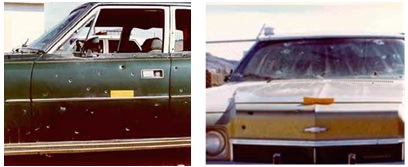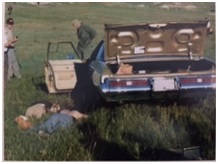
–>
May 19, 2022
“I’m hit” were the last words the FBI heard from Agent Ronald Williams.
‘); googletag.cmd.push(function () { googletag.display(‘div-gpt-ad-1609268089992-0’); }); }
On June 26, 1975, just before noon, FBI agents Jack Coler and Ronald Williams, in separate vehicles, were searching for a fugitive, Jimmy Eagle. The agents followed a suspect suburban containing three individuals from a rural highway onto a dirt road leading to the Jumping Bull family farm in a remote corner of the Pine Ridge Indian Reservation in South Dakota.
The suburban stopped at a distance, as did the agents, who were now exposed in an open field.

The beginning.
The unprovoked attack and what followed are undisputed. Agent Williams was on the FBI radio describing that the three individuals were getting out with rifles and were about to fire at them. As gunfire erupted, personnel in the FBI’s Rapid City office heard Agent Williams trying to describe their location. The radio call for assistance ended with “I’m hit.”
‘); googletag.cmd.push(function () { googletag.display(‘div-gpt-ad-1609270365559-0’); }); }
Unknown to the FBI, and the two agents, was the presence of an American Indian Movement (AIM) camp nearby. They had followed Leonard Peltier, who was also a fugitive at the time. When the shooting began, others from the AIM camp, with rifles, pinned the agents in a deadly crossfire. The attack didn’t last long, but it ended with no fewer than 125 bullets holes in the FBI vehicles.
Agent Coler received a devasting wound to his right arm. Agent Williams, wounded three times, removed his shirt and waved it as a sign of surrender — which was ignored — and crawled to his critically wounded partner, using his shirt as a tourniquet on Agent Coler’s shattered arm. Williams waited, hoping help would arrive quickly, not knowing that the first to find the Jumping Bull farm were also fired upon and forced back to the highway.
Later trial testimony placed the three older AIM Indians, Leonard Peltier, Bob Robideau, and Dino Butler, at the agents’ vehicles. Agent Williams faced his killer as the muzzle of Peltier’s AR-15 was placed against a raised hand and fired — fingers blown through the back of his head. It was hoped that Agent Coler was unconscious as the weapon turned toward him, with two more point-blank bullets to his face.
Peltier and others stole what they could, shot at responding law enforcement, and managed to elude capture.
Eight months later, Leonard Peltier, the FBI Top Ten Fugitive, was arrested in Canada and extradited. In April 1977, in Fargo, North Dakota, he was convicted of murder and aiding and abetting, receiving consecutive life sentences.
The Peltier myth quickly emerged, resting on the notion that since Native American history with the government is dismal at best, Peltier’s plaintive cries of innocence must be true.
‘); googletag.cmd.push(function () { googletag.display(‘div-gpt-ad-1609268078422-0’); }); } if (publir_show_ads) { document.write(“
Feigned innocence aside, a number of times, Peltier changed his version of that June day — and along the way, considered within the context of his public statements, made tacit admissions of guilt while showing no remorse at all. Over nearly two decades, his alibi was that someone else, someone they knew but would not name, the phantom Mr. X in the infamous red pickup, was the one who killed the agents. “This story is true,” Peltier falsely claimed in a television interview. The lie continued until one of his own, Dino Butler, publicly denied it. Later, one of his own attorneys denied it as well.
Aside from AIM’s purported and enticing goals, its history of disruption and violence leaves little doubt that while some leaders became rich and famous, they collectively contributed nothing to the betterment of their people. Peltier’s involvement with AIM was mostly as a bodyguard and enforcer, with one documented incident of placing a gun in the mouth of a suspected FBI informant. Time has proven that the loyal Anna Mae Aquash wasn’t an informant, but nonetheless, AIM leadership ordered her execution.
Peltier-supporters come in a few categories. There are those who disdain America and will use any excuse, whether they believe Peltier or not. Most are not even Native Americans. There are those who have bought into the Peltier folklore without the slightest effort to verify his fabricated claims. And there are individuals who fail to comprehend Peltier’s voluminous and detailed appellate history. This includes recent attorneys, in their zeal and advocacy, who repeat the myth and ignore or misrepresent the facts.
What followed Peltier’s conviction was an endless stream of motions and appeals, well over a dozen, raising efforts to distort the record, often with frivolous filings. The result was that every single issue Peltier raised was reviewed in minute detail by the appellate courts. Some replied with disparaging critiques. One later court decision made Peltier’s guilt unmistakably clear:
Previous federal court decisions provided the (Parole) Commission with ample facts to support its conviction that Peltier personally shot Agents Coler and Williams. … Neither the conviction nor any of the subsequent court decisions have been overturned. (10th Circuit Court of Appeals, 11/04/03)
On that June day, there was no question that the two white men, in civilian clothes, driving late-model sedans with additional antennas, were the Feds. This was common knowledge on the Reservation. Added to this was that one of the passengers with Peltier had been questioned the prior evening by the same two FBI agents, pursuing their search for fugitive, Jimmy Eagle.
Knowing he had been followed by federal agents, and that he was also a fugitive himself at the time and obviously not wanting to be arrested, disproven fabrications aside, Peltier suggests a motive for the unprovoked attack.
Peltier, unsurprisingly, fails to recognize that adding political prisoner to his criminal résumé creates a serious conflict: it then follows that the deaths of Agents Coler and Williams weren’t murders after all, but assassinations. Neither Peltier nor his supporters, nor his attorneys, want to venture down the path of Peltier the assassin. Yet Peltier shamelessly promotes this deception to the public. He was not engaging in political activity, discourse, or dissent that day. He committed a purely, maliciously lawless act. However, he did grasp that dead men make poor witnesses.
The final moments of Ron Williams’s life were revealed during sworn testimony in a later, unrelated trial. During their escape from Pine Ridge, Peltier made a stark admission: “the MFer was begging for his life, but I shot him anyway.”

The end. Jack Coler on the left, a shirtless Ron Williams on the right. Both agents, shot in the face, are found face-down, manhandled in death as the final insult. Adding further offense to the carnage, in a June 2, 2004 email to this writer, Bob Robideau said, “… they died like worms.”
The author was a Green Beret officer and an FBI agent for thirty years. He then flew and was an administrator for Delta’s Corporate Charter department for fifteen years.
<!– if(page_width_onload <= 479) { document.write("
“); googletag.cmd.push(function() { googletag.display(‘div-gpt-ad-1345489840937-4’); }); } –> If you experience technical problems, please write to [email protected]
FOLLOW US ON
<!–
–>
<!– _qoptions={ qacct:”p-9bKF-NgTuSFM6″ }; ![]() –> <!—-> <!– var addthis_share = { email_template: “new_template” } –>
–> <!—-> <!– var addthis_share = { email_template: “new_template” } –>




